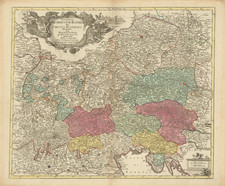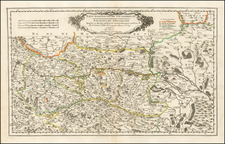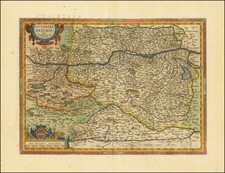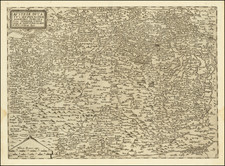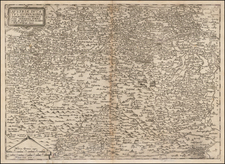This impressive landscape view, created by Georg Braun and Frans Hogenberg and engraved by Georg Hoefnagel after Alexander Colijn, is a remarkable historical document, offering a glimpse of the Inn Valley, Austria, from an easterly perspective. The detail is exquisite, showcasing their topographical prowess and artistic talent, truly a testament to the Golden Age of Cartography during which it was created.
Unusually dynamic for a city atlas, the illustration depicts a lively rural landscape nestled within the dramatic high mountains under an expressive, cloudy sky. This animation imparts a sense of life and vibrancy, reflecting the bustling activity of the era it represents.
On the left, the engraving prominently displays Ambras Castle, which had been in the possession of the Habsburgs since 1363. The name of the castle derives from the Latin phrase "ad umbras," meaning "in the shade," an apt description given its location near a hill, providing a refreshing retreat during the summer months, as mentioned by Braun in his commentary.
The castle was extensively renovated into a Renaissance-style structure by Archduke Ferdinand II when he became the governor of Tyrol in 1563. Archduke Ferdinand II's contribution to the castle was not merely architectural; he also founded the Ambras collections, a remarkable assemblage of art and curiosities. This included the Amraser Heldenbuch, or the Ambras Book of Heroes, an anthology of epic medieval and chivalric tales from the 12th and 13th centuries.
The small village of Amras, now a suburb of Innsbruck, lies below the castle to the right. This detail further highlights the artists' commitment to accurately depict the region's geography and settlement patterns.
In sum, this view serves as a historical record, providing insight into both the landscape and cultural milieu of Innsbruck in the Renaissance period. The illustration is more than just a geographical depiction; it's a testament to the artistry and craftsmanship of the period, capturing the confluence of historical events, architectural developments, and cultural richness in the region.
Georg Braun (1541-1622) was born and died in Cologne. His primary vocation was as Catholic cleric; he spent thirty-seven years as canon and dean at the church St. Maria ad Gradus, in Cologne. Braun was the chief editor of the Civitates orbis terrarum, the greatest book of town views ever published. His job entailed hiring artists, acquiring source material for the maps and views, and writing the text. In this role, he was assisted by Abraham Ortelius. Braun lived into his 80s, and he was the only member of the original team to witness the publication of the sixth volume in 1617.
Frans Hogenberg (ca. 1540-ca. 1590) was a Flemish and German engraver and mapmaker who also painted. He was born in Mechelen, south of Antwerp, the son of wood engraver and etcher Nicolas Hogenberg. Together with his father, brother (Remigius), uncle, and cousins, Frans was one member of a prominent artistic family in the Netherlands.
During the 1550s, Frans worked in Antwerp with the famous mapmaker Abraham Ortelius. There, he engraved the maps for Ortelius’ groundbreaking first atlas, published in Antwerp in 1570, along with Johannes van Deotecum and Ambrosius and Ferdinand Arsenius. It is suspected he engraved the title page as well. Later, Ortelius supported Hogenberg with information for a different project, the Civitates orbis terrarium (edited by Georg Braun, engraved by Hogenberg, published in six volumes, Cologne, 1572-1617). Hogenberg engraved the majority of the work’s 546 prospects and views.
It is possible that Frans spent some time in England while fleeing from religious persecution, but he was living and working in Cologne by 1580. That is the city where he died around 1590. In addition to his maps, he is known for his historical allegories and portraits. His brother, Remigius, also went on to some fame as an engraver, and he died around the same time as his brother.









![(Inn Valley, Austria) Elegantissimus a parte Orientali Oenipontis prospectus. [An exquisitely beautiful view from the eastern part of Innsbruck.]](https://storage.googleapis.com/raremaps/img/small/94422.jpg)
